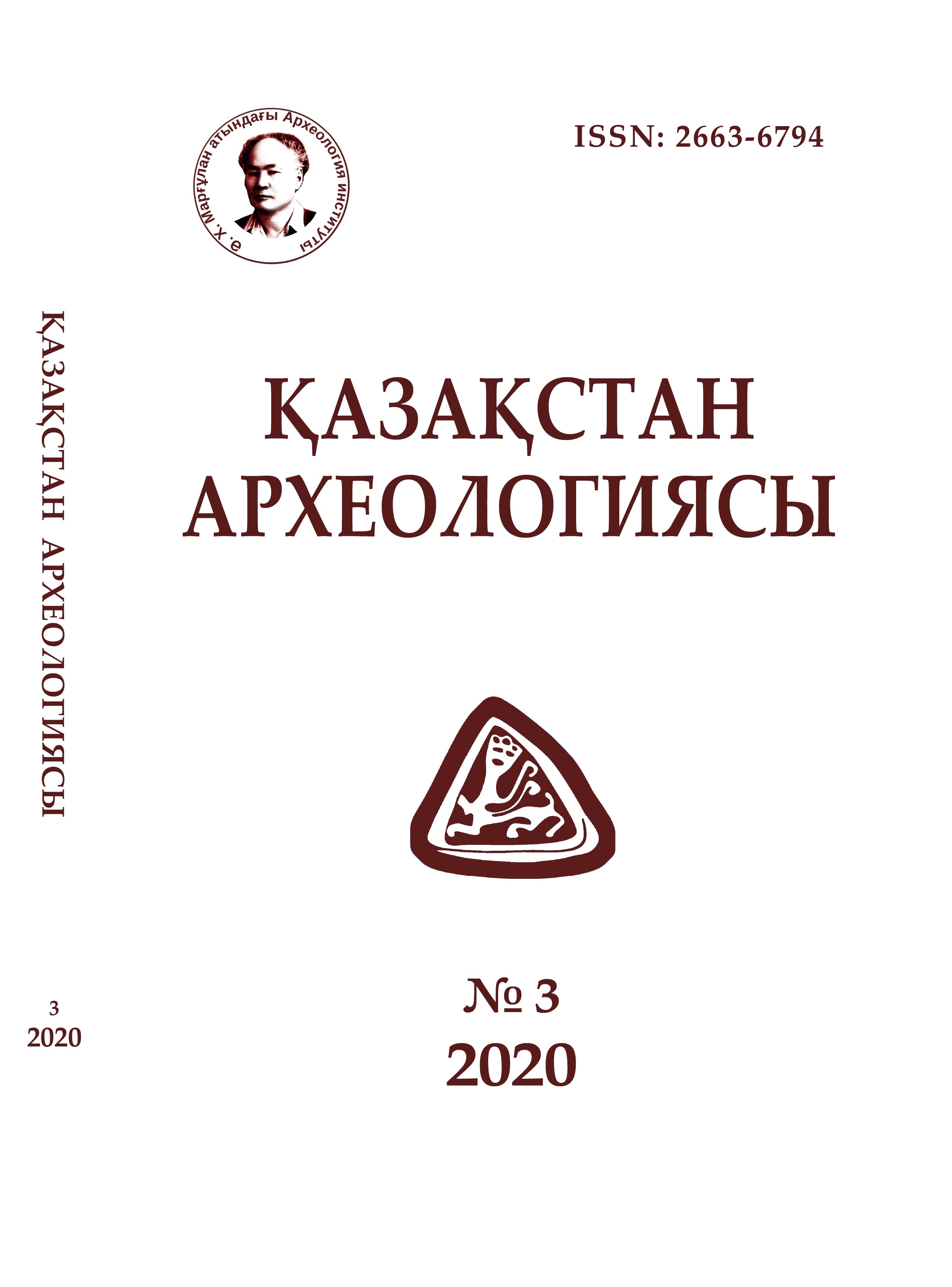QUANTITATIVE ANALYSIS of COIN SILVER of the KHAN KEPEK MONETARY REFORM by the METHOD of EMISSION SPECTRAL ANALYSIS
DOI:
https://doi.org/10.52967/akz2020.3.9.103.117Keywords:
archaeology, Chagataids Khanate, Samarkand, Bukhara, XIII–XIV centuries, coin reform, dirhams, coin metal, elemental composition, silver content, optical atomic emission spectrometry (OAES)Abstract
The study of Chagatai Khan Kebek’s monetary reform character in Bukhara and Samarkand (718–725 AH/1318–1325 AD) was undertaken. To this end, the elemental composition of pre-reform and post-reform dirhams was studied using the destructive method of optical atomic emission spectrometry (OAES). Three groups of coins (I, II - "Masud Bek" dirhamas of the end of XIII - beginning of XIV century and III - post-reform Kebek's dirhamas of Samarkand and Bukhara) were revealed. Previously, the same samples were studied with the help of X-ray fluorescent analysis (XRF). A comparative analysis was carried out with the XRF data. It is established that for high silver alloys (more than 80%) both methods give close results, so the non-destructive X-ray fluorescence method can be used for an indicative estimate of the quantitative and qualitative element composition. In the course of the reform in Bukhara and Samarkand under Khan Kebek, the silver probe of the reformed dirhams was increased from almost 85% (in the "Masud Bek" dirhams) to 97%, that is, by about 10%. At the same time, the exchange market equivalent of pre-reform and reform coins (3 to 4) indicates the same amount of silver in each of these two groups. That is, the monetary reform in Bukhara, and then in Samarkand, under Khan Kebek did not pursue the goal of direct fiscal gain directly due to the economy of the silver amount in dirham. It was aimed at improving trade in the region by improving the silver coin quality.
References
Baitanayev, B. A., Petrov, P. N., Shayhutdinova, E. F. 2019. In: Povolzhskaya arheologiya (The Volga River Region Archaeology), 4 (30), 43–54 (in Russian).
Vostochnye monety iz fondov Tsentralnogo gosudarstvennogo muzeya Respubliki Kazakhstan (Oriental coins from the funds of the Central State Museum of the Republic of Kazakhstan). 2013. Almaty: Tsentralnyi gosudarstvennyi muzey RK. T. 1, kn. 1 (in Russian).
Vostochnye monety iz fondov Tsentralnogo gosudarstvennogo muzeya Respubliki Kazakhstan (Oriental coins from the funds of the Central State Museum of the Republic of Kazakhstan). 2014. Almaty: Tsentralnyi gosudarstvennyi muzey RK. T. 1, kn. 2 (in Russian).
Davidovich, E. A. 1972. Denezhnoe hozyaystvo Sredney Azii posle mongolskogo zavoevaniya i reforma Masud-beka (XIII v.) (Monetary economy of Central Asia after the Mongol conquest and the reform of Masud-bek (XIII century)). Moscow: “Nauka” Publ. (in Russian).
Masson, M. E. 1957. In: Proceedings of the Central Asian State University, CXI, 41–108 (in Russian).
Petrov, P. N. 2004. In: Tezisy dokladov XII Vserossiyskoy numizmaticheskoy konferencii (Abstracts of the XII All-Russian Numismatic Conference). Moscow: State Historical Museum, 76–77 (in Russian).
Petrov, P. N. 2004a. In: Smirnova, N. M. (ed.) Monety i medali (Coins and medals). Moscow: “Dipak” Publ., 169–238 (in Russian).
Petrov, P. N. 2005. In: Petrov, P. N. (ed.) Monety i denezhnoe obrashchenie v mongolskih gosudarstvah XIII–XV vekov (Coins and money circulation in the Mongolian states of the XIII–XV centuries): Moscow: “Numizmaticheskaya Literatura” Publ., 49–77 (in Russian).
Petrov, P. N. 2007. Numizmaticheskaya istoriya Chagataidskogo gosudarstva 668/1270 – 770/1369 gg. (The numismatic history of the Chagataid state 668/1270–770/1369): dis. … Cand. hist. sciences. Kazan: Kazan State University (in Russian).
Petrov, P. N. 2009. In: Tyurkologicheskij sbornik 2007–2008 (Turkological collection 2007–2008). Moscow: “Vostochnaya literatura RAN” Publ., 294–319 (in Russian).
Petrov, P. N., Baipakov, K. M., Voyakin, D. A. 2014. Monetnoe delo i denezhnoe obrashchenie v Velikoy Mongolskoy imperii, gosudarstvah Chagataidov i Juchidov. Kazakhstan (Monetary affairs and monetary circulation in the Great Mongol Empire, the states of the Chagataids and the Juchids. Kazakhstan). Almaty (in Russian).
Shchekin, V. P. 1985. In: Epigrafika Vostoka (Epigraphy of the East), XXIII, 60–62 (in Russian).
Chekhovich, O. D. 1965. Buharskie dokumenty XIV veka (Bukhara documents of the XIV century). Tashkent: “Nauka UzbekSSR” Publ. (in Russian).
Fedorov, M., Kočnev, B., Kurbanov, G., Voegeli, M. 2008. Sylloge Numorum Arabicorum Tübingen. Buhara / Samarqand XVa Mittelasien / Central Asia I. Berlin.
Oliver, E. E. 1892. In: J. Asiatic Society Bengal, 60. Part I. N I – 1891, 8–16 (in English).
Rodgers, Charles J. 1985 Catalogue of the Coins Miscellaneous Muhammadan coins. Part II. Calcutta, 1894. Reprinted in Indian in (Delhi).
Yih T.D., Schüttenhelm R.T.E. 2003. In: Newsletter Oriental Numismatic Society, 174, 11–12.

Downloads
Published
How to Cite
Issue
Section
License
Copyright (c) 2020 Pavel N. Petrov, Bauyrzhan A. Baitanayev, Eugenia F. Shaykhutdinova

This work is licensed under a Creative Commons Attribution-NonCommercial 4.0 International License.






